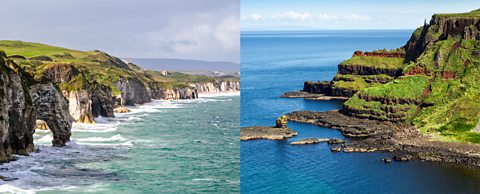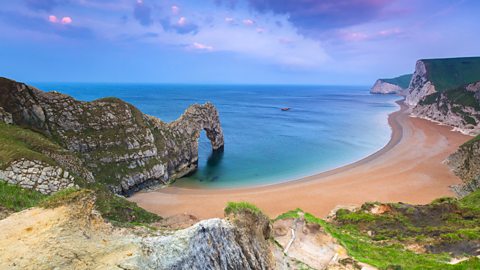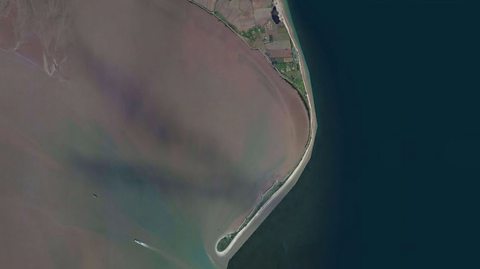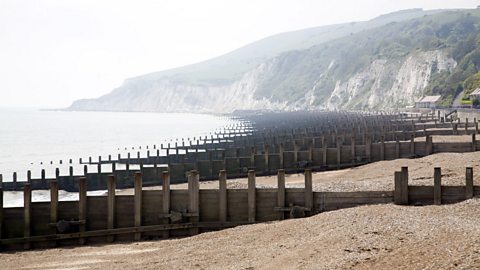Destructive and constructive waves
The power of wavesWaves are created due to the transfer of energy through seawater as the wind blows across the surface of the sea. is one of the most significant forces of coastal change. Waves are created by wind blowing over the surface of the sea.
As the wind blows over the sea, friction is created - producing a swell in the water. The energy of the wind causes water particles to rotate inside the swell and this moves the wave forward.
The size and energy of a wave is influenced by:
- how long the wind has been blowing;
- the strength of the wind;
- how far the wave has travelled (the fetch).
Waves can be destructive wavesWaves that help to erode a beach. They have a lot of energy, are steep and close together with at least 15 waves per minute. or constructive waves Waves that help to build up a beach. They are flat, gentle and low and there are only a few waves per minute..
When a wave breaks, water is washed up the beachA coastal landform which usually contains sand, shingle or pebbles. - this is called the swash.
Then the water runs back down the beach - this is called the backwash.
With a constructive wave, the swash is stronger than the backwash.
With a destructive wave, the backwash is stronger than the swash.
Destructive waves
- Destructive waves are created in storm conditions. They are created from big, strong waves when the wind is powerful and has been blowing for a long time. They occur when wave energy is high and the wave has travelled over a long fetch.
- They tend to erode the coast.
- They have a stronger backwash than swash.
- They have a short wave length and are high and steep.
- They are more frequent (10-14 waves per minute).
- They tend to erode the coast.
- They have a stronger backwash than swash.
- They have a short wave length and are high and steep.
- They are more frequent (10-14 waves per minute).
Constructive waves
- They are created in calm weather and are less powerful than destructive waves.
- They break on the shore and deposit material, building up beaches.
- They have a swash that is stronger than the backwash.
- They have a long wavelength, and are low in height.
- They are less frequent (6-9 waves per minute).
Watch: Coastal processes and landform video
Learn about coastal processes and landforms
Coastal erosion

The sea shapes the coastal landscape. Coastal erosion is the wearing away and breaking up of rock along the coast.destructive wavesWaves that help to erode a beach. They have a lot of energy, are steep and close together with at least 15 waves per minute. erode the coastline in a number of ways:
Hydraulic action: Air may become trapped in joints and cracks on a cliff face. When a wave breaks, the trapped air is compressed which weakens the cliffA high, steep wall of rock that can be eroded by the sea. and causes erosion.
Abrasion: Bits of rock and sand in waves grind down cliff surfaces like sandpaper.
Attrition: Waves smash rocks and pebbles on the shore into each other, and they break and become smoother.
Solution: Acids contained in sea water will dissolve some types of rock such as chalk or limestone.
Coastal transportation
The various types of material found in the sea comes from many different sources - such as:
- being eroded from cliffs;
- being transported by longshore driftWhen eroded material in the sea is carried along the beach in a zig zag course.along the coastline;
- being brought inland from offshore by constructive waves;
- being carried to the coastline by rivers.
This movement of material is called transportationThis takes place when eroded material in the sea is moved from one place to another..
Waves can approach the coast at an angle because of the direction of the prevailing wind.
The swashThe water flowing towards a beach when a wave breaks. of the waves carries material up the beach at an angle.
The backwash then flows back to the sea in a straight line at 90°.
Continual swash and backwash transports material sideways along the coast. This movement of material is called longshore drift and occurs in a zigzag.
There are four ways that waves and tidal currents transport sediment. These can then contribute to the movement of sediment by longshore drift.
| Process | Description |
|---|---|
| Solution | Minerals are dissolved in sea water and carried in solution. The load is not visible. Load can come from cliffs made from chalk or limestone, and calcium carbonate is carried along in solution. |
| Suspension | Small particles are carried in water, eg silts and clays, which can make the water look cloudy. Currents pick up large amounts of sediment in suspension during a storm, when strong winds generate high energy waves. |
| Saltation | Load is bounced along the sea bed, eg small pieces of shingle or large sand grains. Currents cannot keep the larger and heavier sediment afloat for long periods. |
| Traction | Pebbles and larger sediment are rolled along the sea bed. |
Coastal deposition
When the sea loses energy, it drops the sand, rock particles and pebbles it has been carrying.
This is called deposition.
Deposition also happens when the swash of a wave is stronger than its backwash - constructive waves.
Conditions that discourage deposition
Deposition is likely to occur when:
- waves enter an area of shallow water;
- waves enter a sheltered area, e.g. a cove or bay;
- there is little wind;
- there is a good supply of material.

Watch: Longshore drift video
How longshore drift affects the coastline
Activity: Take the quiz
More on Coastal environments
Find out more by working through a topic
- count2 of 4

- count3 of 4

- count4 of 4
